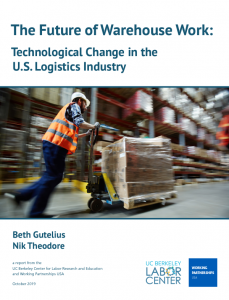Executive Summary:
Are “dark” warehouses, humming along without humans, just around the corner? Predictions of dramatic job loss due to technology adoption and automation often highlight warehousing as an industry on the brink of transformation. The potential elimination of many blue-collar jobs is a pressing issue for policy makers and raises important questions about how workers will fare in the economy of the future.
In contrast to reports focusing only on the number of jobs that could be lost, our research offers an in-depth, detailed look at the range of ways in which warehouse work and the industry as a whole might change with the adoption of new technology over the next five to 10 years. The findings in this report are based on in-depth industry research and extensive interviews with a broad set of stakeholders, including industry analysts and consultants, third-party logistics (3PL) operators, retailers, brands, and technology providers. Specifically, we sought to find out:
- What key industry dynamics are playing a role in technological change?
- How will adoption of new technologies impact warehouse facilities and operations, as well as the overall organization of the industry?
- What tasks and processes are the highest priorities for technological application, and how might adoption of new technologies impact jobs in warehousing?
Authors:
Beth Gutelius,
GCI Senior Research Specialist and Associate Director of the Center for Urban Economic Development.
Nik Theodore,
GCI Fellow, Professor of Urban Planning and Policy and Director fo the Center for Urban Economic Development.
Press Release:
Automation is Making Warehouse Work Harder, Not Smarter – UIC Great Cities Institute
Robots aren’t taking warehouse employees’ jobs, they’re making their work harder – UIC Great Cities Institute
Read the Full Report Here.



